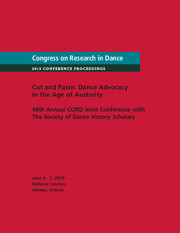No CrossRef data available.
Article contents
Price of Gold and Light: Power and Politics in Hey Ananta Punya
Published online by Cambridge University Press: 04 April 2012
Abstract
Hey Ananta Punya, a dance-drama adapted and choreographed by the Bangladeshi choreographer Warda Rihab was performed in Kolkata, India, in December 2009. Rihab plays the main character Srimoti, a dancer at the court of King Ajatashatru. Srimoti embraces Buddhism but is not allowed to practice since Ajatashatru decrees Hinduism to be the state religion. In the narrative, Hinduism, the predominant religion of India, represses Buddhism, which is a minority religion in the subcontinent. Even though on the surface the dance-drama deals with Hinduism and Buddhism, the performance is complicated by the knowledge that the choreographer and most of the performers are Bangladeshi Muslims. In the context of Hindu-Muslim conflicts and India's political and economic hegemony in South Asia, the performance can be considered as a critique of India's policies. In considering the choreographer's background and the dance-drama's narrative, aesthetics, and location of performance, I analyze the various structures of power that a Bangladeshi female choreographer operates within during her training and performance in India. Hey Ananta Punya is significant because it points to the complex web of issues involving politics, history, and religion that have been a part of dance in Bangladesh for the past few decades because of India's influence in the field, particularly through Indian-government scholarships for advanced dance training. In the paper, I use Michel Foucault's theory of power as systems of interrelated networks and knowledge as a system of power to show how dance as a form of embodied knowledge can function as a tool in shaping, disseminating, and expressing ideology.
- Type
- Research Article
- Information
- Copyright
- Copyright © Munjulika Rahman 2010


